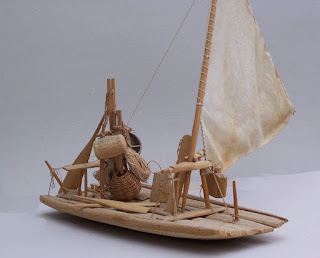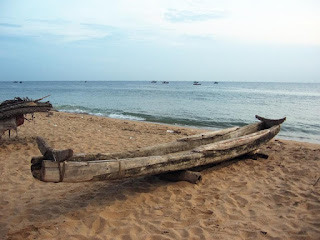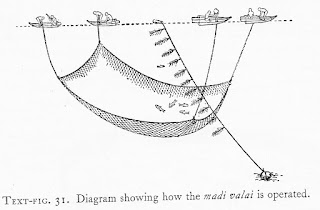Catamarans, of the type used on the Coromandel Coast in India’s
southeast and in Sri Lanka, close by across the Palk Strait, are subject to
two kinds of misconceptions. The first is one of terminology. In its original
meaning, kattu-maram (Tamil for “tied
logs”) denoted a raft, not a vessel with two identical hulls, as the term is
commonly understood. The erroneous transference of the term was probably made
by an early European traveler who, being familiar with Indian catamarans,
decided to call the twin-hulled boats he found in the Pacific by the same name,
it probably seeming logical at the time to call any indigenous, non-European
small craft by the same term. Henceforth, our use of the term will refer only
to the raft.
The second misconception concerns the nature of timber rafts, which are
commonly conceived to be rectangular, flat, and capable only of drifting with
the current rather than being directed according to the boatman’s wishes. Catamarans
are, specifically, shaped rafts of
wood or bamboo, and they behave more like true boats than like the flat, rectangular
platform upon which Huck and Jim floated inexorably down the Mississippi.
 |
| Model of a jangada (source). Click any image to enlarge. |
In Water Transport: Origins and
Early Evolution, James Hornell describes several varieties of catamaran on
India’s east coast and in many other parts of the world. Such craft are still
in use in some locales. We have written about the jangada, a Brazilian
catamaran in current use, and one can easily find with a Google search
contemporary images of catamarans of more than one type on Sri Lanka.
 |
| A three-log raft from Sri Lanka of the type called a "boat catamaran" by Hornell. (source) |
Hornell also distinguishes between catamarans that are more or less
boat-like. In the Sri Lankan type that he calls “boat catamarans,” the central
of three logs extends below the outer two, forming a keel, while the upper
surfaces of the outer ones are considerably higher than that of the central
one, forming an inside space that could be termed a hold or cockpit. In
contrast to this, he describes the “flying fish” catamaran of Coromandel, which
is the main subject of this installment. While it lacks a keel, it has enough
of a depression in its upper surface to have an identifiable “inside,” and it is
considerably more shapely and boat-like than the common conception of a raft.
A seven-log flying fish catamaran of the Coromandel Coast
In Fishing in Many Waters, Hornell
describes in detail the flying fish type and its use, which he observed in the
Tanjore district. Pursuing flying fish requires sailing to deep waters as
far as 25 miles from shore with a crew of seven and staying out for as long as three
days. As such, the deep sea catamaran is a substantial vessel, averaging 30 to
35 feet long. They are built of seven main logs of light wood, dressed on all
sides and tapering from back to front and from bottom to top. Curved logs are
selected, so that, when assembled, the main section of the raft is an isosceles
trapezoid in plan view, and dished both longitudinally and transversely.
The logs are lashed together with coir rope. At the forward end, says
Hornell, “the completed craft becomes definitely wedge-shaped in plan after the
addition of an elegant upturned prow of five pointed pieces cleverly jointed on
to the forward ends of the seven main logs.” Another log is lashed atop the
outermost log on the starboard side to serve as a working platform.
Coromandel flying fish catamaran, showing rig details
The two-masted rig is refined, although it looks crude as a result of
the materials from which it is made. Short masts fit into sockets on the whichever
outside log happens to be to leeward, hoisting lateen or
settee sails. The head of each cotton sail is lashed to a long yard with a short
downward-curving extension at the forward/lower end. The foot of the sail is
lashed to a boom that extends only as far forward as the mast. Between the mast
and the end of the extension-piece of the yard is a foot-rope. The sail,
however, does not extend all the way to the forward apex of the triangle. Its
forward corner or tack is cut off short, so that the sail has a very short luff.
There are forestays and backstays, and the halyards serve as shrouds on
the upwind side. There is also a short strut lashed at its lower end to the windward hull log, and at its upper end to the mast, about three feet from the base. Hornell
writes, “Even with these substitutes for shrouds there is always the danger of
the masts and sails falling overboard should the craft be taken aback by a
sudden change of wind; this, however, is of rare occurrence…so steady is the
wind at the season when these craft are at sea.”
As to control lines, “Each sail is provided with a sheet and a vang or
guy made fast to the upper end of the yard.” The sail can be furled by rolling
it up around the lower boom, and by moving the grommet from which the yard depends down from
the masthead onto one of a series of notches provided for the purpose.
To counter leeway, the raft has two large leeboards and a large-bladed
steering oar, the attachments for none of which are described. Hornell gives
the following dimensions for one raft of typical size:
LOA: 33 feet
beam at forward lashing: 4 feet
beam at aft lashing: 7 feet
forward yard: 29 feet
after yard: 21 1/2 feet
steering oar: 12 feet
forward leeboard: 10 1/2 feet
after leeboard: 9 feet
draft (boards up): 1 foot
The boat is equipped with paddles and oars for when the wind fails. Two
dip nets, consisting of a rectangular piece of netting (measuring 5’6” x 4’9”) with
its short sides tied to poles about 7’ long, are carried. The rest of the
equipment is limited to spare rope, a jar of drinking water, a bundle of cooked
rice, a scoop to throw water on the sails, and three large bundles of
bushes or shrubs, the last of which are key to the curious method of fishing practiced.
The raft is sailed into deep waters until a shoal of flying fish is
sighted. The raft is brought into their vicinity, turned with its starboard
side to windward, and the entire rig is dropped. The bundles of shrubs are then
thrown over the accessory log on the windward side. Each bundle is attached to
a rope of a different length: 300 ft.; 180 ft.; and 60 ft. The bundles act like
sea anchors, and with the raft’s shallow draft, it quickly drifts downwind of
them. (A block of wood tied to each bundle acts like a float, but it’s unclear
from Hornell’s description to what purpose, for it’s clear that
the bundles of shrubs sink to different depths determined by the length of rope
to which they’re tied.)
Flying fish are attracted to the bundles. After a large number of fish
have gathered, one of the bundles is pulled in slowly and carefully. The fish
follow until it is close to the raft, at which time the dip nets come into
play. Each net is operated by two men, one per pole. The net is dipped into the
water nearly vertically, then brought up under the fish and tipped back so that
the fish fall into the boat – the whole proceeding being performed in silence so as not to disturb the fish who remain beside the shrub bundles. When that
group of fish has been disposed of, the next bunch of shrubs is hauled in and
the process repeated.
According to Hornell, the attraction that the bundles hold for the fish
is neither their shade nor the expectation that they harbor small prey upon
which to feed. Rather, the fishing occurs during the flying fishes’ spawning
season, and the bundles replicate the bunches of seaweed upon which they
normally deposit and fertilize their eggs.
Large quantities of flying fish may be caught by this method over the course of two or three days. Fish that are not eaten fresh are sun-dried, but given the long
distance that the rafts sail from shore, it often occurs that the catch may
spoil before it reaches market.
Also in Fishing in Many Waters,
Hornell describes a second method of “shade fishing” from catamarans done off the Coromandel coast near
Madras. Although he does not describe the catamarans, they
are different from those described above, and from the illustration appear to
consist of only four logs and to be manned by just two men. Nor does Hornell identify the fish thus captured. Four
catamarans must cooperate to employ the madi
valai, what Hornell calls (but does not translate as) a “handkerchief net.”
Shade fishing with the madi valai net and four catamarans off of Madras
A long length of coir rope is made up with many strips of palm leaf
between the strands, making a bushy appearance. (We presume the rope appears
far bushier in practice than in the illustration.) One end is tied to a stone
anchor or heavy bunch of turf; the other to a piece of light wood as a float. The anchor rope
is dropped in “several fathoms of water” in an area where current is prevalent,
and allowed to remain until fish collect in its shade.
A large rectangular net is suspended at its corners by four ropes, the
upper ends of which are held by a man in each catamaran. Moving against the
current, the four boats approach the suspended shade rope from downcurrent, with the forward
edge of the net held low and the after edge high. When the men in the forward
two catamarans feel the net contact the shade rope, they begin to pull it up as
quickly as they can, gathering the fish that have collected in its shade.
Although catamarans are still fished in Sri Lanka, I do not know if either of these methods from the Coromandel Coast are still in use.
Sources:
Except where stated otherwise, information and images are from:
James Hornell, Water Transport: Origins and Early Evolution, Cambridge Univ. Press, 1946
James Hornell, Fishing in Many Waters, Cambridge Univ. Press, 1950












